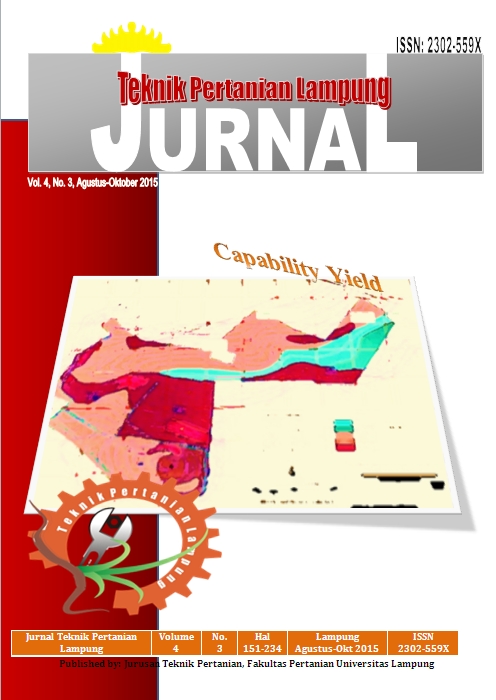THE INFLUENCES OF AVAILABLE SOIL WATER DEPLETION FRACTION TO GROWTHS AND YIELDS OF THREE SOYBEAN (Glycine Max (L) Merril) VARIETIES
Abstract
The objective of this research was to find out the influences of available soil water depletion fraction to growthsand yields of three soybean varieties. This research used a factorial design in a completely randomized design
with the first factor was the available soilwater depletion fraction (p), which contained of three treatment levels
of (p); they were p1 (p=0.2 AW), p2 (p=0.4 AW), and p3 (p= 0.6 AW). The second factor was soybean varieties
containing of three varieties; V1 = Willis, V2 = Kaba, and V3 = Tanggamus, which were repeated three times.
Irrigationwas conducted when soil water levels was close to or above threshold of available soilwater depletion
whichwas determined bymeasuringwater level at gypsumblock and ohmmeter device. Irrigationwas conducted
by returning water level to field capacity condition. Treatment of available soil water depletion fraction for the
plants influences soybean in growth phase ofWilis (V1) variety, Kaba (V2) variety and Tanggamus (V3) variety.
Observation data frominweek 8 of three showed that the highest stemgrowthwas in Kaba variety (55.87 cm) at
p2 treatment (p=0.4 AW). The highest leave amountwas Kaba variety (66.93 leaves) at treatmentp2 (p=0.4 AW).
The highest production was in Kaba variety (71.33gr) at treatment p2 (p=0.4 AW). The highest irrigation
necessitywas in treatment p2with 18mm water irrigation, and then followed by p3with 13.5mm and finally p1
with 9mm. The lowirrigationwater necessity was influenced by high rainfall level of 578mmwith 32 rainy days
during research.
Keywords: soybeans,available soilwaterdepletion fraction, gypsumblock
Downloads
Published
2015-10-30
Issue
Section
Articles
License
- Authors who publish with this journal agree to the following terms:
- Authors retain copyright and grant the journal right of first publication with the work simultaneously licensed under a Creative Commons Attribution-ShareAlike 4.0 International Lice that allows others to share the work with an acknowledgement of the work's authorship and initial publication in this journal.
- Authors are able to enter into separate, additional contractual arrangements for the non-exclusive distribution of the journal's published version of the work (e.g., post it to an institutional repository or publish it in a book), with an acknowledgement of its initial publication in this journal.
- Authors are permitted and encouraged to post their work online (e.g., in institutional repositories or on their website) prior to and during the submission process, as it can lead to productive exchanges, as well as earlier and greater citation of published work (See The Effect of Open Access).
Jurnal Teknik Pertanian Lampung

JTEPL is licensed under a Creative Commons Attribution-ShareAlike 4.0 International License.

